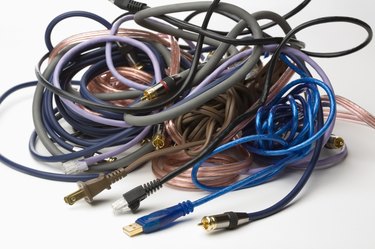Things You'll Need
Wire cutters
Slotted screwdriver

Occasionally, appliances that need 220- or 240-volt power do not come with plugs to fit into a socket. The exact plug end needed depends on whether the household outlet receives three or four prongs. Newer electrical codes require a neutral wire, a ground wire and two hot wires in each 220 plug. The power cord will also have to carry electrical wiring that matches the plug. Plugs sold at hardware outlets are made with screw terminals for easy wiring.
Step 1
Strip 3/4 inch of insulation off the ends of each of the wires with wire cutters. Typical three-wire power cords have red, black and green wires. The four-color scheme includes an additional white wire.
Video of the Day
Step 2
Loosen the screw holding the housing on the plug with a slotted screwdriver. Slip the back end of the housing over the power cord with the stripped wires coming through the front. Loosen the terminal screws on the back of the plug with a slotted screwdriver.
Step 3
Hold a three-prong 220 plug facing away from you with the two slanted prongs on top and the straight one on the bottom. Wrap the stripped end of the red, or hot, wire around the top left terminal and tighten the terminal screw firmly with all wire strands concealed under the screw head. Connect the black wire to the top right terminal, and the green wire to the bottom terminal in the same way.
Step 4
Hold a four-prong 220 plug facing away from you with the "L"-shaped prong at the bottom. Connect the green wire to the bottom "L"-shaped prong terminal, the white wire to the top terminal across from it and the black and red hot wires to either of the two side hot terminals.
Step 5
Pull the plug housing up the power cord and into place over the back end of the plug to cover the electrical wiring. Tighten the holding screw.
Warning
Do not attempt your own electrical wiring unless you have some training or experience with electric circuits.
Video of the Day